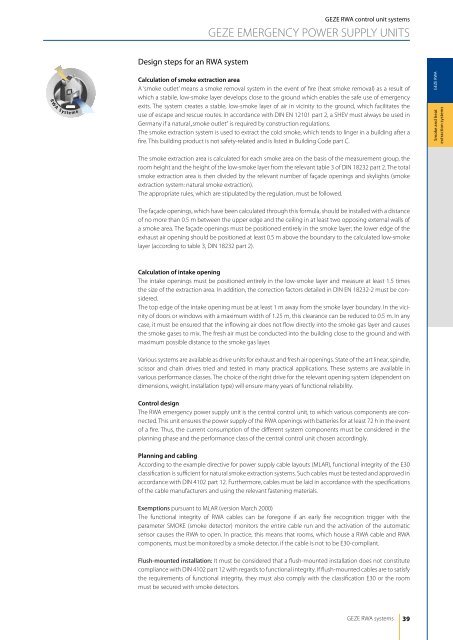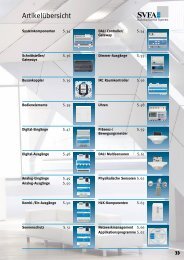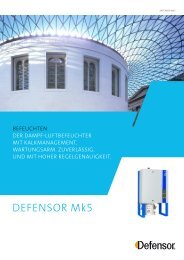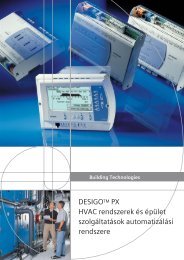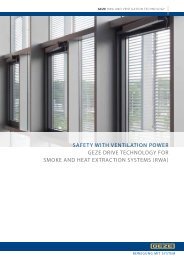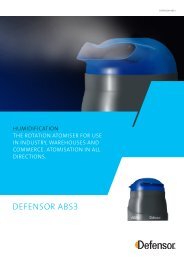Safety with ventilation power_GEZE.pdf
Safety with ventilation power_GEZE.pdf
Safety with ventilation power_GEZE.pdf
Create successful ePaper yourself
Turn your PDF publications into a flip-book with our unique Google optimized e-Paper software.
<strong>GEZE</strong> RWA control unit systems<br />
<strong>GEZE</strong> EMERGENCY POWER Supply UNITS<br />
Design steps for an RWA system<br />
Calculation of smoke extraction area<br />
A ‘smoke outlet’ means a smoke removal system in the event of fire (heat smoke removal) as a result of<br />
which a stabile, low-smoke layer develops close to the ground which enables the safe use of emergency<br />
exits. The system creates a stable, low-smoke layer of air in vicinity to the ground, which facilitates the<br />
use of escape and rescue routes. In accordance <strong>with</strong> DIN EN 12101 part 2, a SHEV must always be used in<br />
Germany if a natural „smoke outlet“ is required by construction regulations.<br />
The smoke extraction system is used to extract the cold smoke, which tends to linger in a building after a<br />
fire. This building product is not safety-related and is listed in Building Code part C.<br />
<strong>GEZE</strong> RWA<br />
Smoke and heat<br />
extraction systems<br />
The smoke extraction area is calculated for each smoke area on the basis of the measurement group, the<br />
room height and the height of the low-smoke layer from the relevant table 3 of DIN 18232 part 2. The total<br />
smoke extraction area is then divided by the relevant number of façade openings and skylights (smoke<br />
extraction system: natural smoke extraction).<br />
The appropriate rules, which are stipulated by the regulation, must be followed.<br />
The façade openings, which have been calculated through this formula, should be installed <strong>with</strong> a distance<br />
of no more than 0.5 m between the upper edge and the ceiling in at least two opposing external walls of<br />
a smoke area. The façade openings must be positioned entirely in the smoke layer; the lower edge of the<br />
exhaust air opening should be positioned at least 0.5 m above the boundary to the calculated low-smoke<br />
layer (according to table 3, DIN 18232 part 2).<br />
Calculation of intake opening<br />
The intake openings must be positioned entirely in the low-smoke layer and measure at least 1.5 times<br />
the size of the extraction area. In addition, the correction factors detailed in DIN EN 18232-2 must be considered.<br />
The top edge of the intake opening must be at least 1 m away from the smoke layer boundary. In the vicinity<br />
of doors or windows <strong>with</strong> a maximum width of 1.25 m, this clearance can be reduced to 0.5 m. In any<br />
case, it must be ensured that the inflowing air does not flow directly into the smoke gas layer and causes<br />
the smoke gases to mix. The fresh air must be conducted into the building close to the ground and <strong>with</strong><br />
maximum possible distance to the smoke gas layer.<br />
Various systems are available as drive units for exhaust and fresh air openings. State of the art linear, spindle,<br />
scissor and chain drives tried and tested in many practical applications. These systems are available in<br />
various performance classes. The choice of the right drive for the relevant opening system (dependent on<br />
dimensions, weight, installation type) will ensure many years of functional reliability.<br />
Control design<br />
The RWA emergency <strong>power</strong> supply unit is the central control unit, to which various components are connected.<br />
This unit ensures the <strong>power</strong> supply of the RWA openings <strong>with</strong> batteries for at least 72 h in the event<br />
of a fire. Thus, the current consumption of the different system components must be considered in the<br />
planning phase and the performance class of the central control unit chosen accordingly.<br />
Planning and cabling<br />
According to the example directive for <strong>power</strong> supply cable layouts (MLAR), functional integrity of the E30<br />
classification is sufficient for natural smoke extraction systems. Such cables must be tested and approved in<br />
accordance <strong>with</strong> DIN 4102 part 12. Furthermore, cables must be laid in accordance <strong>with</strong> the specifications<br />
of the cable manufacturers and using the relevant fastening materials.<br />
Exemptions pursuant to MLAR (version March 2000)<br />
The functional integrity of RWA cables can be foregone if an early fire recognition trigger <strong>with</strong> the<br />
parameter SMOKE (smoke detector) monitors the entire cable run and the activation of the automatic<br />
sensor causes the RWA to open. In practice, this means that rooms, which house a RWA cable and RWA<br />
components, must be monitored by a smoke detector, if the cable is not to be E30-compliant.<br />
Flush-mounted installation: It must be considered that a flush-mounted installation does not constitute<br />
compliance <strong>with</strong> DIN 4102 part 12 <strong>with</strong> regards to functional integrity. If flush-mounted cables are to satisfy<br />
the requirements of functional integrity, they must also comply <strong>with</strong> the classification E30 or the room<br />
must be secured <strong>with</strong> smoke detectors.<br />
<strong>GEZE</strong> RWA systems<br />
39


